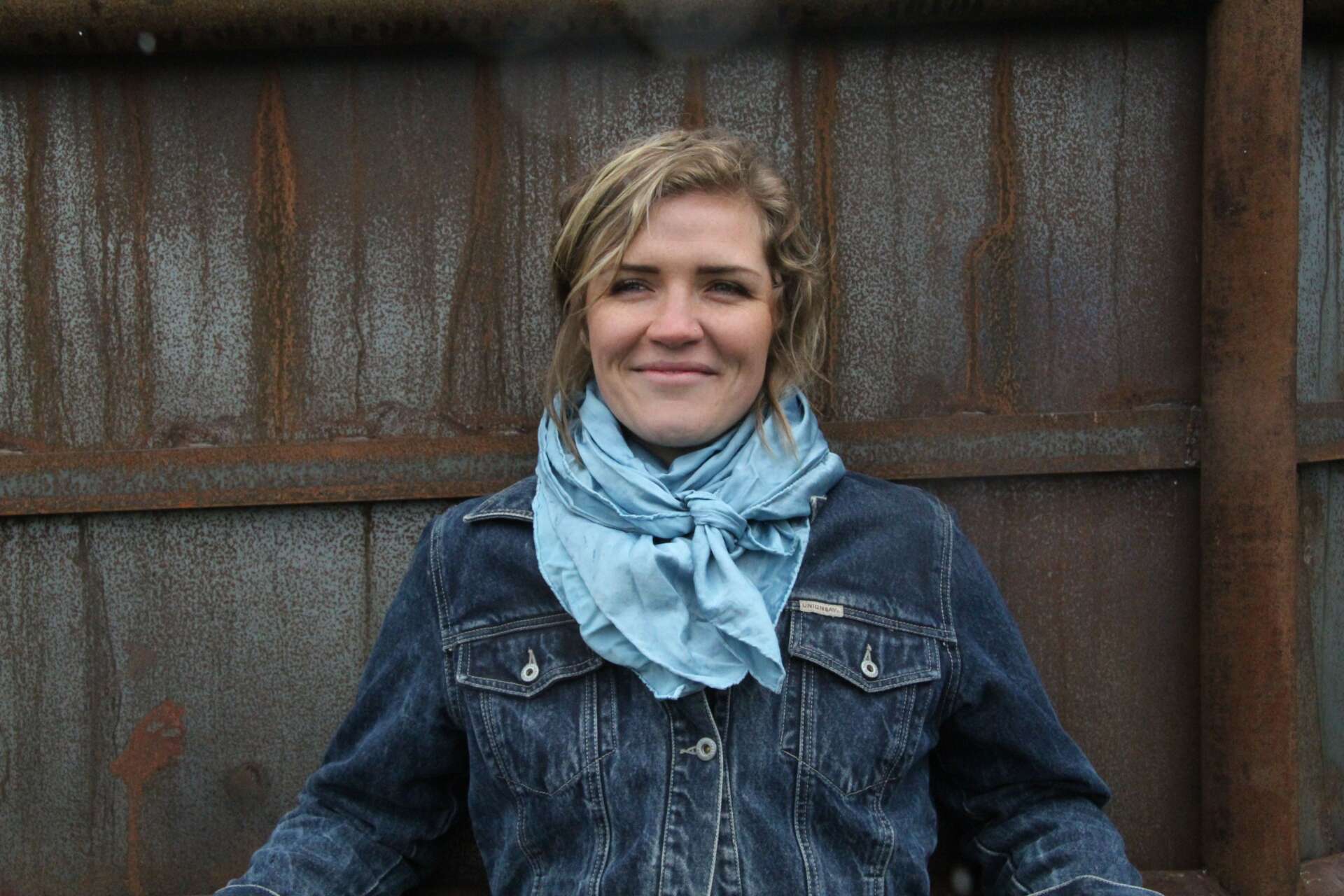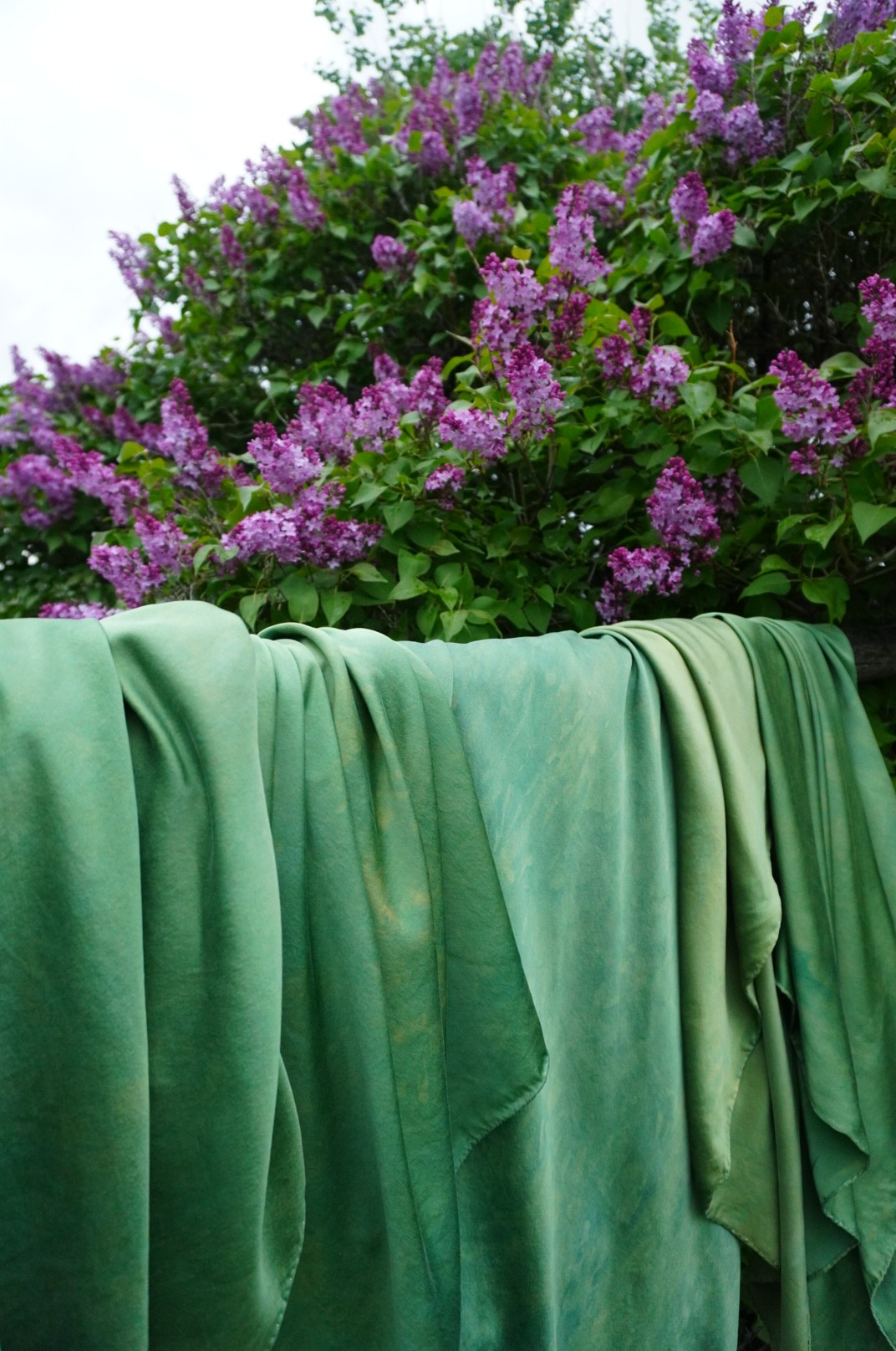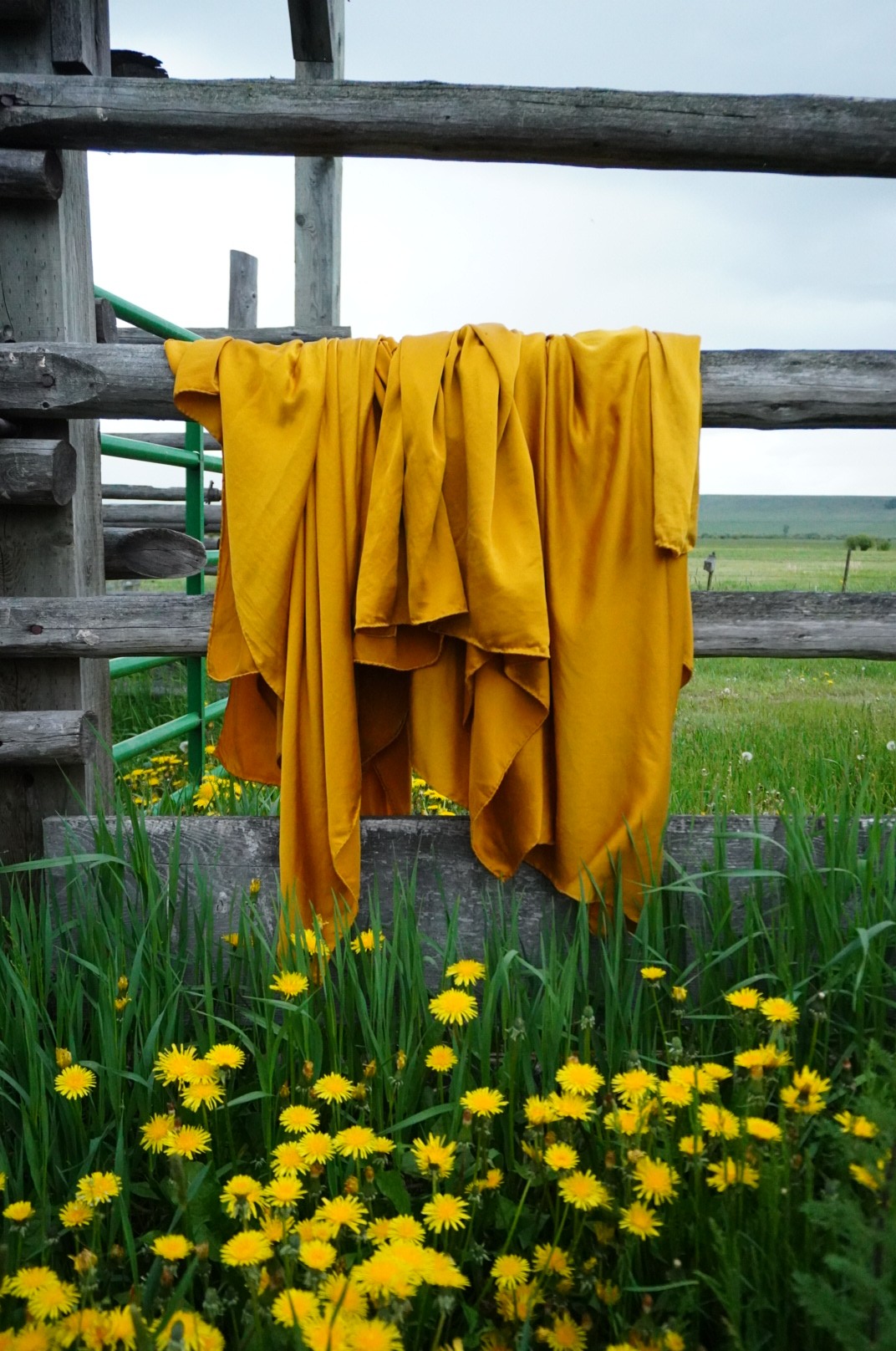We recently connected with Kate Mannix and have shared our conversation below.
Kate, looking forward to hearing all of your stories today. So, naming is such a challenge. How did you come up with the name of your brand?
I was diagnosed with a rare form of ovarian cancer in May of 2020, right smack in the middle of Covid. After recovery from an emergency surgery (they removed a melon sized tumor) I began an intensive chemo treatment. For five days in a row I would receive a cocktail of chemicals intravenously for about 5 hours a day. The treatment made me very sick, and it took about another week after the final day before I began feeling ok again. I had about one good week before I would start the cycle all over again. Having such an intense treatment meant that I couldn’t work at the time, so I spent much of my good week exploring the art of dyeing with plants and insects, as sort of a healing activity during the time I felt good. I had been interested in natural dyes before – having seen some really amazing artists make incredible quilts with hand dyed linens and cottons. During treatment I really got to dive in and begin exploring all of the dyes in my environment. Many of the dyes that have been used for hundreds of years grow in more temperate or tropical regions than Montana – but the most prolific dye plant in the Rockies is Sagebrush. It grows just about everywhere. So I collected sagebrush stems and would coax the color out of them – a lovely buttery yellow. With many of the yellow plant dyes, if you add some iron – old rusty horse shoes and tools are a great source of iron – you will shift the hue to a mossy, sage green. Living on a ranch, old rusty things are a dime a dozen. So basically, if you take some rust, and you take some sagebrush – you’ll make my favorite color – sage green. Hence, rusty sagebrush. Although I import many of the dyes I use from other regions, I like to have my name as a callback to the dyes that grow here on the ranch. I mention my cancer because although I had been exploring a bit of dyeing in the months previous to getting sick – the prospect of mortality really jumpstarted Rusty Sagebrush – it would take about 6 months, but the courage to go out on a limb with my creativity really started by readjusting my priorities after cancer. I think it’s safe to say that without cancer, Rusty Sagebrush wouldn’t exist.



As always, we appreciate you sharing your insights and we’ve got a few more questions for you, but before we get to all of that can you take a minute to introduce yourself and give our readers some of your back background and context?
I come from an ecology background. I grew up in the woods of Northern California, studied forest ecology and agriculture in college, and eventually found my way into ranching in Montana – the ecology of rangeland and ungulates on the western plains. Throughout all of my academics and career, my north star has always been the relationship of humans to nature. I became interested in forestry because wood products have been the background of human development, and provide one of our most basic needs – shelter. Wood is an infinitely sustainable resource, if we manage it correctly. Similarly, I have always been connected to agriculture – the relationship of people to their food. I became a rancher because I learned of the importance of grazing animals to grassland health, and find it incredible that cattle and other stock can turn grass – a thing that it is inedible to humans, into the most nutrient dense form of food in the world – protein. Again, ranching is an infinitely sustainable resource, if managed correctly.
When I first learned about natural dyes, my love for botany, visual awe of the unique hues, and ethics of trying to consume only sustainable resources all aligned. The textile industry has had a devastating impact on the environment. Synthetic fabrics have saturated our entire world with microplastics, and the wastewater from industrial dyes is incredibly toxic to the watersheds and environments surrounding factories. Not to mention the socio economics of textiles – slavery, child laborers, unsafe working conditions, poor wages for women, you name it. To say that the current state of textiles is unsustainable is to put it very, very lightly. Botanical dyes are all derived from plant materials, and are completely non-toxic. I put everything in my garden’s compost at the end of it’s life. They can only be used on natural materials – cotton, linen, silk, wool, etc. Their hues are incredibly unique – it takes several iteration of any industrial dye to try and recreate the nuanced colors of natural dyes.
When I first began dyeing, I worked exclusively with cellulose fibers – those derived from plants. Primarily linen and cotton. Then, one day, I wondered about dyeing a wild rag for myself. Wild rags are deeply entrenched in western and cowboy culture. A square scarf, they wrap around the neck and keep the dust out in the summer and the cold out in the winter. Silk is the perfect material for a wild rag – it feels lovely on your neck, and is incredibly durable against the wind and snow. Being a natural fiber, it’s naturally resistant to microbes and you can go months without washing it.
Once I began dyeing silk, I was absolutely hooked. The silk takes the color absolutely beautifully – I have yet to see a color come out ugly on silk. Many natural dyers are true scientists – they take data points, develop precise recipes. I take the opposite approach. Dyeing is a completely creative and free expression for me. I use recipes as a starting point, but let the creativity flow from there – combining dye baths, trying different combinations, and recording none of my results. That’s why many of the colors I produce are one-of-a-kind (or rather, 2 of a kind, since that’s how many fit in a pot).
I see Rusty Sagebrush as a culmination of two of my great loves – textiles and working landscapes. I still spend most of my time working on the ranch. I dye early in the morning and late in the evening, as well as weekends. My wild rags come to work with me most days – heavy silks to keep the wind off my neck in the winter, a silk bandana to keep the hay chaff off my neck in the summer. Many of my customers also make their living off the land. Many do not, but find that having a silk wild rag connects them to western culture, whether they live in NYC or Montana.
Potentially my favorite thing about being a maker is connecting and working with other makers. The northern rockies has a plethora of incredible (mostly female) makers who create heirloom products, inspired by the west and history of working landscapes. Together, I feel like we are creating a market for handcrafted, western inspired goods. Many of these women also make their living off of the land. I feel very blessed and proud to be a part of such an inspiring community.



How did you build your audience on social media?
Here’s a controversial statement – more does not always equal better. I think we get caught up in having thousands of followers on social media, but how many of those followers are actually supporting your business? My approach to social media has been slow and organic. I have done very little traditional forms of social media marketing. I’ve only made a handful of reels! Personally, I have a limited amount of energy I want to feed into social media, so I’ve set boundaries around it and done what feels right. Instead of spending a lot of time creating content, I’ve spent a lot of time building relationships. These relationships have not only added a ton of value to my life, but they’ve created an intentional and dedicated community of supporters online. I’ve done this by supporting other makers I admire as much as possible. Whether that’s asking to bring some of their products with me to a vending event, or purchasing their goods for a giveaway. I was also blessed by an opportunity to invite all of the makers I love to a regenerative agriculture festival we had on the ranch. Almost every single person we invited came to the event, and it was an unforgettable opportunity to meet all of these folks in-person. There is no substitute for in-person connection, and I find social media to be a great way to build off of those real friendships. I think by building relationships with other makers I admire, we’ve built a market for handmade, land-based, western influenced goods. I think you can sense the community we have through our online presence, and I’m very happy to say that it’s based on true, good old fashioned connection and friendship.


Can you tell us about a time you’ve had to pivot?
As I mentioned before, I have a background in Forestry. By the age of 24 I had earned both a bachelor’s and master’s degree, been published in several peer reviewed scientific journals, and was gainfully employed at a consulting company in Montana. I bought a house, asked my partner at the time if he wanted to get married, and settled in to live the life I had built thus far. Within a year, I realized I could see my entire life laid out ahead of me. I wasn’t excited about any of it. I had security. I was cashing in on all of my schooling and experience thus far. But I was deeply unhappy. I had promoted myself out of field work with my skillset, so I was spending most of my days working at a computer.
It took me about another year to gain the courage to upend the entire life I had built up to that point. I ended my relationship, rented out my house, left my career, and moved to a cow camp on the Mescalero Apache Reservation in New Mexico. I had no experience with livestock of any kind, hadn’t ridden a horse in 10 years, and knew only one person in the state of New Mexico. I had been working with ranches in Montana helping with some of the paperwork for putting land under conservation easement. We would get to go spend a day exploring a ranch, documenting where the buildings and development were already located. Every time I saw cowboys moving cattle or working with equipment, I would get a pang in my heart. Maybe in another life, I thought. Maybe then I could try that thing that I had no background in, but was aching to try.
All that to say, that within a week of starting work on the ranch in New Mexico, I knew I had found my life’s work. I love working with my hands. I love working with animals. I love how ranching is the perfect alignment of my values when it comes to working landscapes, the daily problem solving that I get to apply my brain to, and the strength it builds in my body to exert myself physically each day. I love being outside in the fresh air, even when it’s cold and crisp in the winter.
Since making the big brave choice to leave my career and jump into something entirely new and foreign, every domino has fallen into place. I moved home to Montana after a year in New Mexico, met my husband on the third ranch I worked on. I now work for his family’s 5th generation ranch. I wore my first wild rag when I moved back to Montana and discovered the amazing properties of silk. Making that one brave choice has made every change I’ve made since then easy. There’s no way I would be here now if I hadn’t learned how to step outside my comfort zone and leave everything I knew and had worked for.
Contact Info:
- Website: www.rustysagebrush.com
- Instagram: https://www.instagram.com/rustysagebrush/?hl=en
Image Credits
All images credited to Kate Mannix


